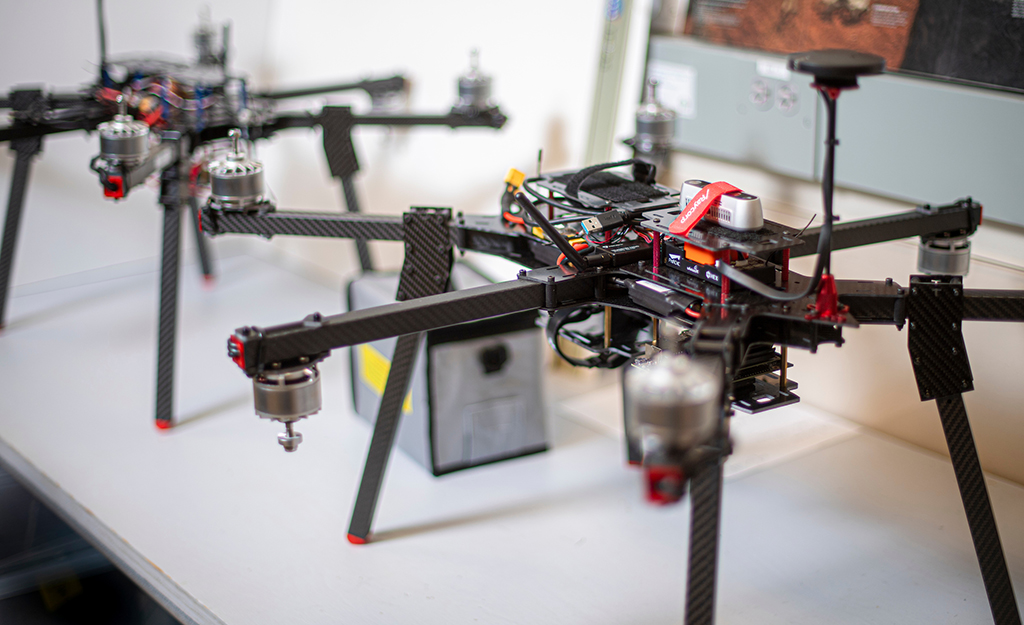
UNT’s Center for Integrated Intelligent Mobility Systems (CIIMS) has announced plans to build an outdoor meshed test facility for air and ground autonomous vehicle research and development. The structure will significantly increase UNT’s research capacity for unmanned aerial vehicles – known as UAVs – and other emerging areas of research, including UAV cooperation with autonomous cars.
The netted facility — proposed to be 80 feet high with at least a 100 by 300 ft. footprint — will be built at UNT’s Discovery Park and allow researchers to conduct field tests in all weather conditions in full compliance of the Federal Aviation Administration (FAA), which regulates the testing of UAVs flown in open air space. It also will have ground-based equipment designed to test autonomous cars together with UAVs for vehicle-to-vehicle communications, information sharing and cooperation in autonomous operations.
“We can fly drones — even the big drones — in this space, and it will be considered indoors by the FAA,” says Terry Pohlen, senior associate dean of the G. Brint Ryan College of Business, director of UNT's Jim McNatt Institute for Logistics Research and co-director of CIIMS. “We’ll be able to fly them in a safe, controlled environment.”
The facility will enable testing and analysis of UAV technology, performance and safety criteria, including collision avoidance with obstacles and other vehicles, the effects that maneuvers make on flight dynamics and controls, batteries, communication, and logistics. Construction is expected for completion in late 2022.
“This is one of the first facilities in the Southwest, and we believe it will be the largest such facility in the country, setting UNT apart from other universities,” says Shengli Fu, professor and chair of the Department of Electrical Engineering. “We will enable the collaboration between aerial and ground vehicles to conduct all kinds of research.”
Researchers from computer science to physics and from geography to health and public service will be able to use the facility. CIIMS was formed with a multidisciplinary focus to leverage researchers from not only engineering and logistics but those in other areas as well. Co-directors Pohlen and Andrey Voevodin, associate dean for research in the College of Engineering, are working to ensure UNT is a leader in multiple areas, not just UAV research.
“We are advancing all aspects of research from mobility technology to business practices to the community acceptance of the technology with the cooperation of industry,” Voevodin says.
Drone usage will grow in coming years, Voevodin adds. The commercial drone industry is poised to take off with UAVs between recreational and military drones — for home package delivery, take-out food orders, monitoring environment and human impact on natural resources, assisting first responders and even air taxis in the not so distant future. Some projections cite that within a year or two, up to 200,000 commercial drones will be produced.
“This facility is where these approaches can be tested and not only the technology — we’re talking about the optimal method of delivery, integration with other transpiration methods, addressing the noise, recharging station and communication infrastructure and all the other variables,” Voevodin says.
“Companies that are currently serving the defense industry will shift to the commercial industry. When this shift occurs, companies will need to have the new uses approved by the FAA and will seek a facility to test them.” Pohlen says. “UNT will be primed to work with industry on testing these different configurations, so we can accelerate the commercialization. It puts us right at the forefront from a research perspective because we’re going to be working with these companies as they move forward with developing use cases for drones.”
Funding for the netted facility project comes from the Jim McNatt Institute for Logistics Research, the College of Engineering, the Division of Research and Innovation, and the Office of the President. CIIMS is seeking additional funding from outside partners and funding agencies. The new facility, along with CIIMS’ indoor autonomous vehicle demonstration facility, will set UNT researchers up in seeking state and federal funding for autonomous vehicle research.
“The establishment of a netted facility will facilitate further growth of UNT’s intelligent mobility research and foster greater opportunities for our researchers to engage with industry and other institutions,” says UNT President Neal Smatresk. “The forward-thinking and collaborative research that will take place in the facility will position CIIMS as a leader in intelligent mobility research — a leader in logistics and supply chain management research and education — and connect UNT to workforce development in this critically needed area.”
With an on-site test facility, CIIMS researchers can accelerate the speed with which they conduct research and will grow partnerships with autonomous vehicle industry.
“It will allow our faculty to submit more proposals with the National Science Foundation, Air Force, Department of Defense and Department of Energy,” Fu says.
In addition to research and industry collaboration, CIIMS also wants to use the facility for community outreach to encourage student interest in STEM careers by getting them excited about drones and autonomous vehicles.
“We want to engage high school students with flying UAVs to entice them with the educational opportunities at UNT and show them how they could be a part of the research we are doing,” Pohlen says. “This facility will promote and advance UNT research and our educational programs.”